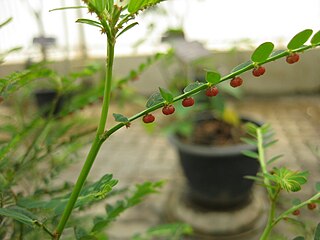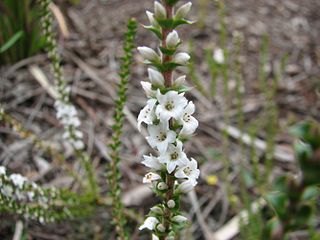
Phyllanthus is the largest genus in the plant family Phyllanthaceae. Estimates of the number of species in this genus vary widely, from 750 to 1200. Phyllanthus has a remarkable diversity of growth forms including annual and perennial herbs, shrubs, climbers, floating aquatics, and pachycaulous succulents. Some have flattened leaflike stems called cladodes. It has a wide variety of floral morphologies and chromosome numbers and has one of the widest range of pollen types of any seed plant genus.

Phyllanthus urinaria, commonly called chamber bitter, gripeweed, shatterstone, stonebreaker or leafflower, is a species of suffruticose and herb in the family Phyllanthaceae.

Phyllanthus emblica, also known as emblic, emblic myrobalan, myrobalan, Indian gooseberry, Malacca tree, or amla, from the Sanskrit आमलकी (āmalakī), is a deciduous tree of the family Phyllanthaceae. Its native range is tropical and southern Asia.

Liparophyllum gunnii, commonly known as alpine marshwort, is a species of aquatic flowering plants in the family Menyanthaceae. It is the type for the genus Liparophyllum. It is a wetland plant having a rhizomatous root structure and alternate linear leaves. Its flowers occur singly, are five-petalled, and white. Flowers bud and open from December to February; fruits form from December through April. L. gunnii is indigenous to Tasmania and New Zealand.

Nothofagus gunnii, the tanglefoot or deciduous beech, is a deciduous shrub or small tree endemic to the highlands of Tasmania, Australia. It was described in 1847 by R.C Gunn N. gunnii is a small woody tree with a shrubby appearance known to grow up to 8 metres (26 ft). It lives only on mountains due to temperature limitations within the Tasmanian maritime climate and mainly grows at altitudes greater than 800 metres (2,600 ft) above sea level. It grows in alpine and sub-alpine regions in the central portions of the island. Though capable of reaching the size of a small tree, it is most common as a thick shrub or woody ground cover, hence its common name of "tanglefoot".

Eucalyptus gunnii, commonly known as cider gum, is a species of large tree in the flowering plant family Myrtaceae. It is endemic to the island of Tasmania, Australia. It has mostly smooth bark, lance-shaped to egg-shaped adult leaves, flower buds in groups of three, white flowers and cylindrical to barrel-shaped fruit.

Frankenia pauciflora, the common sea-heath or southern sea-heath, is an evergreen shrub native to southern Australia. It is part of the Frankenia genus of the Frankeniaceae family.

Phyllanthus caroliniensis, the Carolina leafflower, is a flowering plant native to the Americas, from the southeastern United States all the way to Argentina. The flowers are small and located where the leaf meets the stem.

Asperula gunnii, the mountain woodruff, is a species of flowering plant in the family Rubiaceae. It is a perennial herb that is endemic to Australia.

Epacris gunnii is a species of flowering plant in the family Ericaceae and is endemic to south-eastern Australia. It is an erect shrub with hairy branchlets, concave, sharply-pointed, broadly egg-shaped leaves, and tube-shaped, white flowers arranged along the stems.

Acacia gunnii, commonly known as ploughshare wattle or dog's tooth wattle, is a woody shrub which is endemic to south-eastern Australia found in dry heaths and woodlands. It ranges from Queensland, then New South Wales, Australian Capital Territory, Victoria, South Australia, down to Tasmania. Acacia gunnii grows to up to 1 metre high and has prickly phyllodes which are 4 to 15 mm long. The cream to pale yellow globular flowerheads appear singly in the axils of the phyllodes in June to October, followed by curved or coiled seed pods which are 40 mm long and 4 to 5 mm wide. Acacia gunnii grows up to 1 meter tall and has prickly phyllodes which are 4 to 15mm in length with cream to pale-yellow globular flower heads appearing in phyllode axils in June through to October, followed by curved or coiled seed pods which are 40mm long and 4 to 5 mm wide. The species was first formally described by English botanist George Bentham in the London Journal of Botany in 1842. It occurs in South Australia, Victoria, Tasmania, New South Wales, Australian Capital Territory, and Queensland.

Epiphyllum phyllanthus, commonly known as the climbing cactus, is a species of epiphytic cacti. It has no leaves, instead having stems that photosynthesise. It is thought to be pollinated by hawkmoths, as the flowers only open at night and produce a strong fragrance.

Persoonia gunnii is a species of flowering plant in the family Proteaceae and is endemic to Tasmania. It is an erect shrub with young branchlets that are hairy at first, spatula-shaped to egg-shaped leaves with the narrower end towards the base, and white to cream-coloured flowers.

Persoonia muelleri, commonly known as Mueller’s geebung, is a shrub endemic to Tasmania. It forms a shrub in open areas of wet forests in the west and northeast of the state. It is occasionally confused with P. gunnii though it has larger flowers and longer, straighter leaves.

Phyllanthus maderaspatensis is a perennial herbaceous species of plant in the family Phyllanthaceae, widespread in tropical and subtropical areas of the old world.

Poa gunnii is a Tasmanian endemic tussock grass considered one of the most abundant and common in alpine and subalpine environments from about 800 m to above 1400 m. However it can be found to near sea level in the south of the island state where a cooler climate is prevalent. The genus Poa belongs to the family Poaceae. Tasmania has 16 native and 6 introduced species of Poa.

Phyllanthus tenellus is a herbaceous plant in the leafflower family, Phyllanthaceae. It is commonly called Mascarene Island leaf flower as it is native to the Mascarene Islands. It is often a weed in flower beds, gardens, roadsides, and other disturbed areas.

Phyllanthus calycinus, known as false boronia and snowdrop spurge, is a small shrub in the family Phyllanthaceae, which grows to heights from 20 cm to 1.2 m, often on sandy soils. It is found in both Western Australia and South Australia. In Western Australia its white-cream to pink flowers may be seen from June to January, and in South Australia, from May to October.

Phyllanthus fluitans, also known as the red root floater, floating spurge, or apple duckweed is a species of free floating aquatic plant and herbaceous perennial in the family Phyllanthaceae. This species is one of the only three non-terrestrial species in the genus Phyllanthus, with the other species being P. leonardianus and P. felicis. The generic name comes from Ancient Greek meaning leaf or a leaf flower, and the specific name comes from Latin meaning floating or float. It was described in March 1863 by George Bentham and Johannes Müller Argoviensis.

Spyridium gunnii is a species of flowering plant in the family Rhamnaceae and is endemic to Tasmania. It is an upright shrub with more or less glabrous, egg-shaped leaves, the narrower end towards the base, and mostly more than 12 mm (0.47 in) long. The heads of flowers are arranged in cymes surrounded by 2, 3 or more floral leaves. The sepals are about 3 mm (0.12 in) long and woolly-hairy on the outside.




















